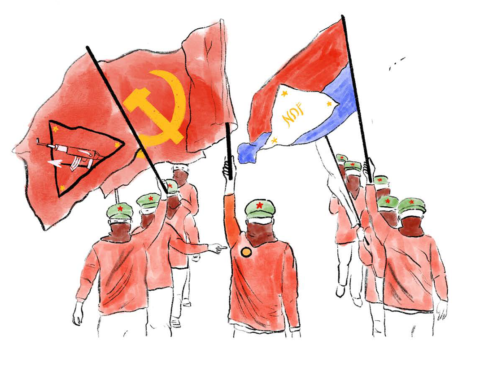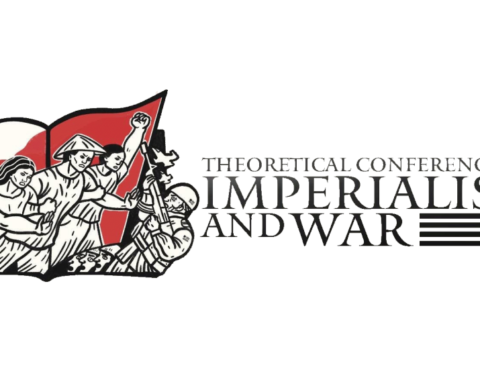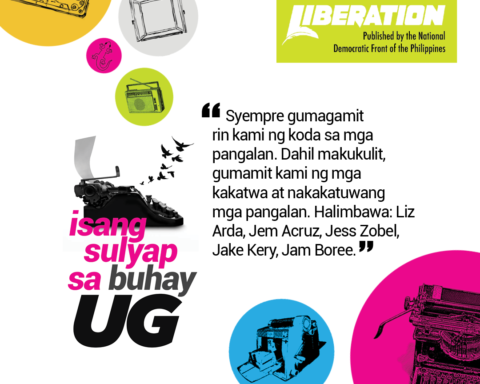A not so typical classroom is found usually deep in the forest. It is a regular feature whenever the red fighters are encamped. At the center of the “classroom,” nestled among trees, is a canvas or black tarpaulin or manila paper that serves as “blackboard.” Around it, members of the people’s army gather—sitting on rocks or on the ground—as they intently listen on their facilitator. At times, the seriousness is interrupted by laughter when they fumble in identifying letters or numbers.
With pens and paper, the Red fighters learn the alphabet—the vowels and consonants—as they read and write the lesson for the day. A member of the red army who had gone to school usually acts as facilitator as he/she also learns how to adapt to the students’ needs and to fashion creatively the teaching method to ease the learning process. Teaching literacy and numeracy has to be woven into the daily lives and experiences of the members of the people’s army. It makes learning easier and retention of lessons faster.
Thus, even as the sound of A-BA-KA-DA reverberates in the forests, it is not the usual “A is for apple” but “A is for Ambus (ambush), B is for baseng masa (mass base), K is for kasama (comrade), and D is for digmang bayan (people’s war).
These classrooms, like the NPA units, are mobile, too. Wherever and whenever the situation allows, the Red fighters always find time to study—literacy, numeracy, and theoretical studies. Learning is a collective practice, too. Tutorials are practiced among students, with the more advance learner assisting those who have difficulties with their lessons. The more determined students, and those who want to keep pace with their classmates, continue to study in the evenings, making do with whatever light is available or allowed in camp sites.
Making up for government neglect in education
Majority of the Red fighters came from the peasantry; many of them have not gone to school or had stopped schooling at an early age. Despite the free tuition in public schools, children stop going to school because their families cannot afford the cost of transportation, the expenses for school projects, and a host of other expenses, even snacks. Other families who survive on a daily basis need their children to lend a hand in household or farm chores, or to do odd jobs as in the case of urban poor dwellers. Illiteracy has been a cause of discrimination as well as exploitation especially for peasants and indigenous peoples when they trade with other sections of the population.
Hence, literacy and numeracy become part of the daily lives of the people’s army. It strengthens the Red fighters’ confidence when they know how to read and write. It also facilitates their study and grasp of Marxism, Leninism, and Maoism. This improves the knowledge and skills they impart to the masses.
In some guerrilla zones in Mindanao, for example, Red fighters were also taught basic science before they attend the Basic Party Course. These basic science concepts aid the members of the people’s army in understanding the core concepts of dialectical and historical materialism.
The revolutionary movement’s education program
Literacy and Numeracy is only among the many courses offered by the Party to its members, the Red army, and the masses.
As part of its cultural revolution, and guided by nationalist, scientific, and mass-based principles, the Party consolidates its membership and the masses through its education program. The various courses also prepare the NPA and the masses in establishing and administrating the revolutionary organizations and the organs of political power in the countryside.
The three-level education in the Party—basic, intermediate, and advance—aims to deepen the members’ understanding of Marxism, Leninism, and Maoism, and how they are applied to Philippine society and revolution.
Activists also learn from various courses on national democracy through the Pambansang Demokratikong Paaralan (PADEPA) or the national democratic school. Subjects on Philippine society, the national democratic revolution, revolutionary perspective and attitude, special courses on women, indigenous peoples, peasants, and workers, and analyses on various national issues such as the peace negotiations are among those taught in the PADEPA.
Special courses and skills training on various fields are also available—military, health and medicine (including surgery), math and science, arts and literature, leadership and management, national and international laws and protocols, philosophy, etc.—given for free in the people’s army and the Party.
These courses, along with revolutionary practice, steel the members of the revolutionary movement, strengthen their will to fight and win the national democratic revolution.
Meet the Graduates
(Adapted from “Mandirigmang mag-aaral, gerilyang paaralan” Bigwas, February 2022 issue, official publication of West-Central Luzon)
Ka Dyun, a red fighter from the Aeta indigenous group
One of his teachers called him bobo (stupid) because he was unable to read a word written on the board. He was shut in a room until he filled the board with that one word, which surprisingly he couldn’t remember anymore. Ka Dyun was traumatized by the experience, he lost his confidence that he decided to leave school at an early age. He only finished grade one. Little did he know that when he joined the red army he would attend school again, this time, in the pulang paaralan (red school.)
Ka Dyun was motivated by his desire not just to serve the people, but to serve them the best he could. He learned how to read and write to gain confidence and to hone himself as a capable and skilful Red fighter. With the help of his comrades in the people’s army, he diligently studied writing and reading during classes and in the evenings, when their schedule allowed.
Bit by bit, he learned to write his name, then the letters of the alphabet; write and read words related to their situation and surrounding until he was able to construct and read sentences.
The daily accounting of his platoon’s supplies and resources was his practical exam in addition, subtraction and multiplication. How to determine the rate of exploitation of traders and landlords among the peasants and indigenous peoples where they operate became a higher learning in arithmetic.
Slowly but progressively, he and his collective succeeded in Ka Dyun’s schooling. Ka Dyun was especially grateful to Ka Islaw, a martyred comrade who used his drawing skills to facilitate Ka Dyun’s learning. To Ka Dyun, Ka Islaw’s inspiration will continue to propel him to learn and hone his skills and become a well-rounded revolutionary for the victory of the revolution and the masses.
Ka Baytan, Ayta from Zambales
It took him and his brother two hours to reach their school, alternately crossing river tributaries and lahar several times. At school, Ka Baytan and all the other pupils were cramped in two small rooms. One room is shared by those in Grades 1 to 3; the other room for pupils in Grades 4 to 6.
In a room, a teacher segregates the pupils by row per grade level but they are either seated side-by-side or back-to-back; each grade level doing their own activity simultaneously. One grade level may be reading, the other writing, and the other reciting. This is what the Department of Education calls the “multi-grade system” which is implemented in far-flung communities because of lack of teachers and school facilities. The set-up discouraged Ka Baytan to continue studying such that when he reached Grade 3 he stopped.
Because a Red fighter is also a cultural worker, Ka Baytan’s interest in music and learning to read and write converged. He did not only sing during cultural activities but copying lyrics of revolutionary songs to his notebook taught him writing and eventually reading.
His interest in studying was definitely revived when he joined the people’s army. For one, he had 10 Red fighters who alternately taught him to read, write, and count. He was also encouraged to continue learning because he realized that his lack of education from the bourgeois school system did not hinder him to learn Marxism-Leninism, and Maoism.
When he finished the Basic Party course, Ka Baytan was in high spirits, having experienced for the first time to graduate. “Dito lang ako sa hukbo nakaranas na grumadweyt”, he said during the graduation rites held by his unit of the people’s army. (Iliya Makalipay) ###








